|
Battle of Shiloh
First Day of Battle
| Battle of Shiloh Civil War Map |
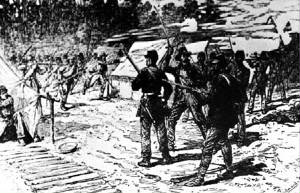
|
| (Shiloh Battlefield) |
The Confederate charge upon Prentiss' camps.
From "Battles and Leaders
of the Civil War."
The First Day
The battle began about 4:55 a.m., Sunday, April 6, when a reconnoitering
party of Prentiss' Union division encountered Hardee's skirmish line, under Maj. Aaron B. Hardcastle, a short distance in
front of Sherman's camps. The reconnoitering party—three companies of the 25th Missouri under Maj. James E. Powell—fighting
and retreating slowly toward its camps was reinforced by four companies of the 16th Wisconsin and five companies of the 21st
Missouri. These troops were, in turn, reinforced at the northeast corner of Rhea Field by Col. Everett Peabody's entire brigade.
Here they succeeded in holding the Confederates in check until about 8 a. m., when they fell back to Prentiss' line of camps,
closely followed by the enemy.
| Civil War Battle of Shiloh First Day Map |
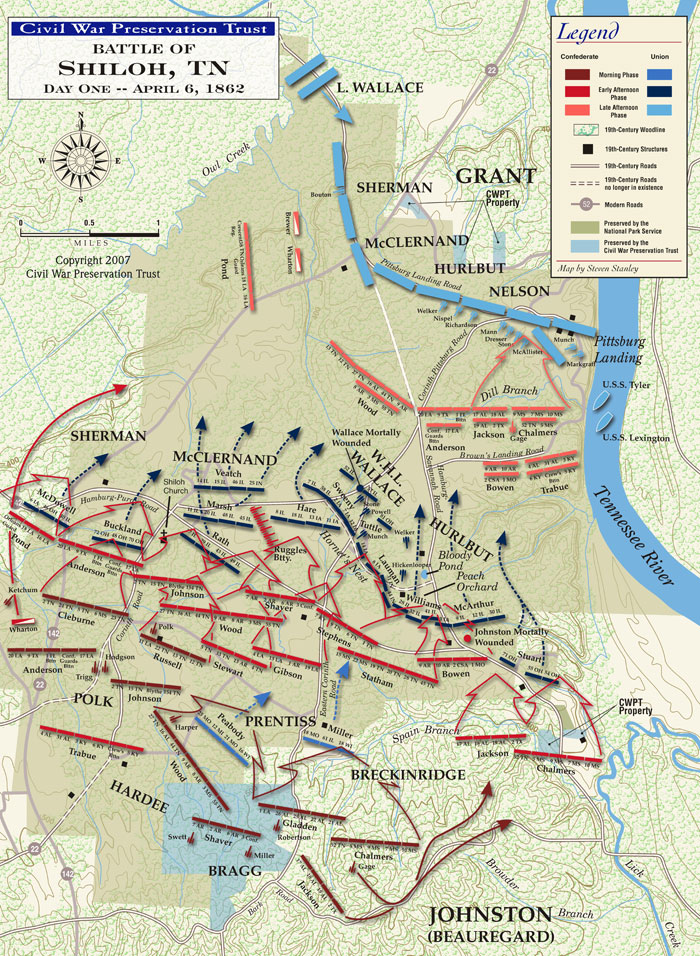
|
| Battle of Shiloh Map, Courtesy Civil War Trust |
General Sherman, hearing the picket firing in his front, immediately
got his division under arms and posted a battery at Shiloh Church and another on the ridge to the south. The left of this
hastily formed line received the full impact of the Confederate onslaught at about the same time that Prentiss' camps were
attacked. One of the regiments in the left brigade—the 53d Ohio—consisted of raw troops who had never been under
fire. Unable to withstand the fierce Confederate attack, this regiment soon broke and fled to the rear. A short time later
the other two regiments of the brigade did likewise. The commander of the brigade, Col. Jesse Hildebrand, refused to leave
the field with his men. Since he had no troops of his own, he acted as aide for General McClernand the rest of the day.
| Hornet's Nest at Battle of Shiloh |
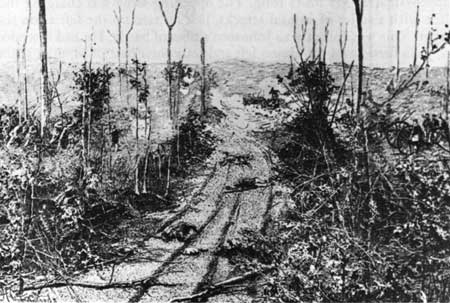
|
| (Hornet's Nest) |
Union defenders of the Hornets' Nest (right) repulsed 11 Confederate charges against
the Sunken Road.
General Prentiss, in the meantime, was making a gallant, but futile, stand
along his line of camps. Assailed by the eager Confederates in front and on the flanks, his whole division soon broke and
fell back in confusion. He succeeded in rallying about 1,000 of his men on the center of a line that W. H. L. Wallace and
Hurlbut were forming with parts of their divisions in a strong position in the rear. This new line, running through a densely
wooded area along an old sunken road, proved to be such a strong position that the Confederates named the place "Hornets'
Nest" because of the stinging shot and shell they had to face there.
| The Sunken Road near Bloody Pond. |
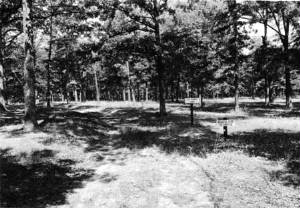
|
| (Battle of Shiloh Map) |
The Sunken Road near Bloody Pond.
Meanwhile, General Grant at breakfast in Savannah heard the
guns in the battle of Shiloh. He at once sent word to the advance of Buell's army, which had already arrived at Savannah,
to march immediately to the point on the river opposite the battlefield. He then hurried up the river aboard the steamer Tigress,
moving in close enough to the shore at Crump's Landing to instruct Gen. Lew Wallace to be prepared to execute any order he
might receive. Upon arriving at the field, he dispatched reinforcements to Prentiss and formed two regiments in line near
Pittsburg Landing, to arrest the tide of stragglers from the battle and organize them to return. He then rode to the front.
While the Confederate right was engaged with Prentiss, the left,
supported by continuous artillery fire, was hurled against the combined forces of Sherman and MeClernand who were making a
stubborn stand along the ridge at Shiloh Church. This small log building, which gave its name to the battle, was considered
the key position of the field, as it commanded the best road from Corinth to Pittsburg Landing. When General Grant reached
the church, about 10 a.m., his troops were heavily engaged all along the line. They had resisted the relentless pounding from
the Confederate artillery and the repeated infantry charges for over 2 hours. Seeing that the line could not hold much longer,
Grant dispatched orders to Lew Wallace to move to the field, expecting him to reinforce the Union right. Leaving Sherman,
he moved down the line to the left to confer with his other division commanders. He visited Prentiss in the Hornets' Nest
and directed him to hold his position there at all hazards.
| General Joseph Johnston |
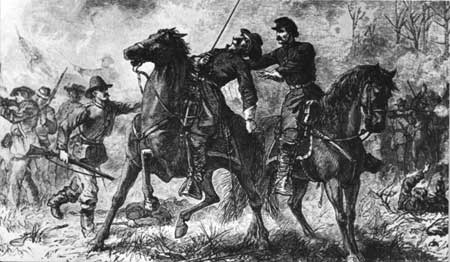
|
| (Battle of Shiloh) |
Johnston mortally wounded.
Soon after Grant's departure, Sherman withdrew from Shiloh Ridge,
abandoning his camps and much of his equipment. He took a new position behind the Hamburg-Purdy Road alongside MeClernand
who had been pushed back on line with Prentiss' Hornets' Nest position.
Grant's army was now posted on either side of Prentiss, making
a line approximately 3-1/2 miles long. The opposing army was charging this line with a series of frontal attacks, just as
hard on the left as on the right. This was contrary to Johnston's plan of battle. He had intended to push hardest on the Union
left and seize their base of supplies at the Landing. Without supplies or an avenue of escape, he hoped to drive the disorganized
Federals into the swamps of Snake and Owl Creeks and destroy them.
Seeing that the enemy was being driven into its base of supplies
rather than away from it, Johnston, about noon, moved to the extreme right to direct in person the activities of that wing
of his army. There, he found his troops exposed to a galling fire and unable to advance. Determined to move his line forward,
Johnston ordered and led a successful charge. The Union lines recoiled, and the Confederates surged forward about three-fourths
of a mile. As Johnston sat on his horse, watching the lines reform, a ball from the gun of an unknown Union soldier struck
the Southern commander, severing the large artery in his right leg. No surgeon being near, he died from loss of blood at 2:30
p.m.
The death of Johnston caused a lull in the battle on the right
flank for about an hour. The situation was relieved somewhat by the fact that a second in command was on the field. Gen. Pierre
G. T. Beauregard was in charge of headquarters which had been established near Shiloh Church. When informed of Johnston's
death, he immediately assumed command. He sent General Bragg to the right of the field and put Gen. Daniel Ruggles in command
at the center.
| Confederate Plan of Battle of Shiloh Map |
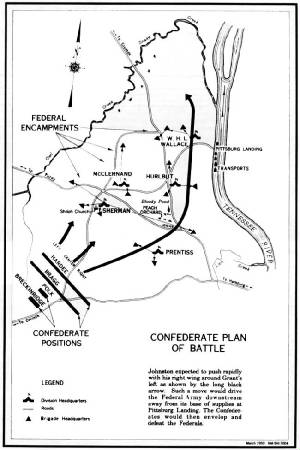
|
| (Click to Enlarge) |
Confederate Plan of Battle.
General Ruggles, having witnessed 11 unsuccessful charges against
the Hornets' Nest, decided to concentrate artillery fire upon the position. Therefore, he collected all the artillery he could
find—62 pieces—and opened fire upon the Union line. Under cover of continuous fire from these guns, the Confederates
attacked with renewed courage and redoubled energy. Unable to withstand the assault, the troops on both the Federal right
and left withdrew toward the Landing, leaving Prentiss and W. H. L. Wallace isolated in the Hornets' Nest. As the Union forces
withdrew, the left of the Confederate line swung around and joined flanks with the troops moving around from the right, thus
forming a circle of fire around Wallace and Prentiss.
Wallace, seeing that the other divisions were withdrawing and
that his command was being surrounded, gave the order for his troops to fall back. To execute the order, his division had
to pass through a ravine which was already under the crossfire of the encircling Confederates. Wallace was mortally wounded
in the attempt, but two of his regiments succeeded in passing through the valley, between the Confederate lines which they
appropriately named "Hell's Hollow." Prentiss continued the resistance until 5:30 p.m., when he was compelled to surrender
with over 2,200 troops—all that remained of the two divisions.
During the afternoon, Col. Joseph D. Webster, Grant's Chief
of Artillery, placed a battery of siege guns around the crest of a hill about a quarter of a mile in from the Landing. The
smaller field artillery pieces were put in position on either side of them as they were moved back from the front. The two
wooden gunboats, Tyler and Lexington, anchored opposite the mouth of Dill Branch, further strengthened the line.
As the remnants of the shattered Union Army drifted back toward the Landing, they were rallied along this line of cannon.
| General Ulysses S. Grant |
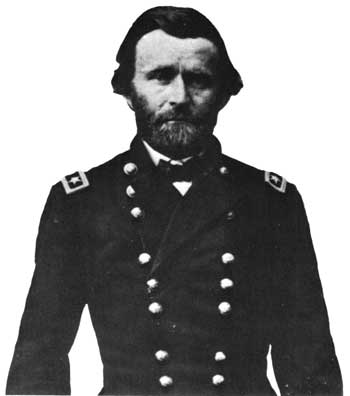
|
| (Battle of Shiloh) |
Gen. Ulysses S. Grant.
Courtesy National Archives.
After the capture of Prentiss, an attempt was made to reorganize
the Confederates for an attack upon the Union position near the Landing. Before a coordinated attack could be made, Beauregard,
who had received word that Buell would not arrive in time to save Grant's army, sent out the order from his headquarters at
Shiloh Church to suspend the attack. Unknown to Beauregard, the advance of Buell's army had already arrived opposite Pittsburg
Landing and was being rapidly ferried across the river.
During Sunday night and Monday morning, Buell moved approximately
17,000 troops into line on the Union left. Lew Wallace put almost 6,000 fresh troops—Fort Donelson veterans—in position on the right. The Confederates, receiving no reinforcements,
spent a sleepless night in the captured Union camps annoyed by shells from the gun boats, which were thrown among them at
15-minute intervals through out the night.
| General Don Carlos Buell |
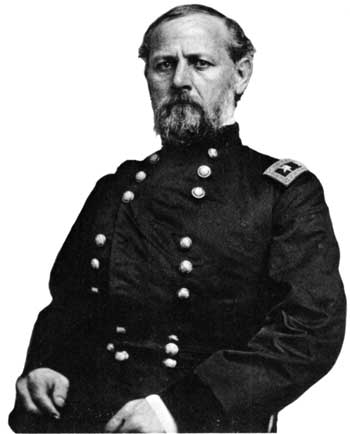
|
| (Battle of Shiloh) |
Gen. Don Carlos Buell.
Courtesy National Archives.
The battle had already raged for 13 hours. Charge after charge
had been made by the Confederates, followed by Federal countercharges. Ground had been gained and lost, but the general direction
of movement had always been toward the Landing. By the time the day was over and the weary soldiers had lain down to rest,
the Confederates were in possession of the entire field, except the Landing and a bit of adjoining territory. Many
Southern soldiers, in view of the gains made during the day, believed that the victory was already theirs. An equally large
number of Northerners were willing to concede defeat. When night at last closed in around the hostile armies, feelings of
uncertainty prevailed among the leaders on both sides. Many of them were well aware that the battle was yet to be won or lost.
(Sources listed at bottom of page.)
Recommended
Reading: Shiloh: The Battle
That Changed the Civil War (Simon & Schuster).
From Publishers Weekly: The bloodbath at Shiloh, Tenn.
(April 6-7, 1862), brought an end to any remaining innocence in the Civil War. The combined 23,000 casualties that the two
armies inflicted on each other in two days shocked North and South alike. Ulysses S. Grant kept his head and managed, with
reinforcements, to win a hard-fought victory. Continued below…
Confederate
general Albert Sidney Johnston was wounded and bled to death, leaving P.G.T. Beauregard to disengage and retreat with a dispirited
gray-clad army. Daniel (Soldiering in the Army of Tennessee) has crafted a superbly researched volume that will appeal to
both the beginning Civil War reader as well as those already familiar with the course of fighting in the wooded terrain bordering
the Tennessee River.
His impressive research includes the judicious use of contemporary newspapers and extensive collections of unpublished letters
and diaries. He offers a lengthy discussion of the overall strategic situation that preceded the battle, a survey of the generals
and their armies and, within the notes, sharp analyses of the many controversies that Shiloh
has spawned, including assessments of previous scholarship on the battle. This first new book on Shiloh
in a generation concludes with a cogent chapter on the consequences of those two fatal days of conflict.
Recommended
Reading: Shiloh--In Hell before Night. Description: James McDonough has written a good, readable and concise history of
a battle that the author characterizes as one of the most important of the Civil War, and writes an interesting history of
this decisive 1862 confrontation in the West. He blends first person and newspaper accounts to give the book a good balance
between the general's view and the soldier's view of the battle. Continued below…
Particularly
enlightening is his description of Confederate General Albert Sidney Johnston, the commander who was killed on the first day
of the battle. McDonough makes a pretty convincing argument that Johnston fell far short of the image that many give him
in contemporary and historical writings. He is usually portrayed as an experienced and decisive commander of men. This book
shows that Johnston was a man of modest war and command experience,
and that he rose to prominence shortly before the Civil War. His actions (or inaction) prior to the meeting at Shiloh -- offering
to let his subordinate Beauregard take command for example -- reveal a man who had difficulty managing the responsibility
fostered on him by his command. The author does a good job of presenting several other historical questions and problems like
Johnston's reputation vs. reality that really add a lot of
interest to the pages.
Recommended
Reading: Seeing the Elephant: RAW RECRUITS AT THE BATTLE
OF SHILOH.
Description: One of the bloodiest battles in the Civil War, the two-day engagement near Shiloh,
Tennessee, in April 1862 left more than 23,000 casualties. Fighting alongside
seasoned veterans were more than 160 newly recruited regiments and other soldiers who had yet to encounter serious action.
In the phrase of the time, these men came to Shiloh to "see the elephant". Continued below…
Drawing on
the letters, diaries, and other reminiscences of these raw recruits on both sides of the conflict, "Seeing the Elephant" gives
a vivid and valuable primary account of the terrible struggle. From the wide range of voices included in this volume emerges
a nuanced picture of the psychology and motivations of the novice soldiers and the ways in which their attitudes toward the
war were affected by their experiences at Shiloh.
Recommended
Reading: Shiloh: A Novel, by Shelby Foote. Review: In the novel Shiloh, historian and Civil
War expert Shelby Foote delivers a spare, unflinching account of the battle of Shiloh, which
was fought over the course of two days in April 1862. By mirroring the troops' movements through the woods of Tennessee with the activity of each soldier's mind, Foote offers the reader a broad perspective
of the battle and a detailed view of the issues behind it. Continued below…
The battle
becomes tangible as Foote interweaves the observations of Union and Confederate officers, simple foot soldiers, brave men, and cowards and describes
the roar of the muskets and the haze of the gun smoke. The author's vivid storytelling creates a rich chronicle of a pivotal
battle in American history.
Recommended
Reading: Shiloh and the Western Campaign
of 1862. Review: The bloody and decisive two-day
battle of Shiloh (April 6-7, 1862) changed the entire course of the American Civil War. The
stunning Northern victory thrust Union commander Ulysses S. Grant into the national spotlight, claimed the life of Confederate
commander Albert S. Johnston, and forever buried the notion that the Civil War would be a short conflict. The conflagration
at Shiloh had its roots in the strong Union advance during the winter of 1861-1862 that resulted in the capture of Forts Henry
and Donelson in Tennessee. Continued below…
The offensive
collapsed General Albert S. Johnston advanced line in Kentucky and forced him to withdraw all the way to northern Mississippi. Anxious to attack the enemy, Johnston began
concentrating Southern forces at Corinth, a major railroad center just below the Tennessee border. His bold plan called for his Army of the Mississippi to march north and destroy General Grant's Army of the Tennessee
before it could link up with another Union army on the way to join him. On the morning of April 6, Johnston
boasted to his subordinates, "Tonight we will water our horses in the Tennessee!"
They nearly did so. Johnston's sweeping attack hit the unsuspecting Federal camps at Pittsburg
Landing and routed the enemy from position after position as they fell back toward the Tennessee River.
Johnston's sudden death in the Peach Orchard, however, coupled
with stubborn Federal resistance, widespread confusion, and Grant's dogged determination to hold the field, saved the Union
army from destruction. The arrival of General Don C. Buell's reinforcements that night turned the tide of battle. The next
day, Grant seized the initiative and attacked the Confederates, driving them from the field. Shiloh
was one of the bloodiest battles of the entire war, with nearly 24,000 men killed, wounded, and missing. Edward Cunningham,
a young Ph.D. candidate studying under the legendary T. Harry Williams at Louisiana
State University, researched and wrote Shiloh and the Western Campaign of 1862 in 1966. Although it remained unpublished, many Shiloh
experts and park rangers consider it to be the best overall examination of the battle ever written. Indeed, Shiloh
historiography is just now catching up with Cunningham, who was decades ahead of modern scholarship. Western Civil War historians
Gary D. Joiner and Timothy B. Smith have resurrected Cunningham's beautifully written and deeply researched manuscript from
its undeserved obscurity. Fully edited and richly annotated with updated citations and observations, original maps, and a
complete order of battle and table of losses, Shiloh and the Western Campaign of 1862 will
be welcomed by everyone who enjoys battle history at its finest. Edward Cunningham, Ph.D., studied under T. Harry Williams
at Louisiana State
University. He was the author of The Port Hudson Campaign: 1862-1863
(LSU, 1963). Dr. Cunningham died in 1997. Gary D. Joiner, Ph.D. is the author of One Damn Blunder from Beginning to End: The
Red River Campaign of 1864, winner of the 2004 Albert Castel Award and the 2005 A. M. Pate, Jr., Award, and Through the Howling
Wilderness: The 1864 Red River Campaign and Union Failure in the West. He lives in Shreveport,
Louisiana. About the Author: Timothy B. Smith, Ph.D., is author of Champion Hill:
Decisive Battle for Vicksburg (winner of the 2004 Mississippi
Institute of Arts and Letters Non-fiction Award), The Untold Story of Shiloh: The Battle and the Battlefield, and This Great
Battlefield of Shiloh: History, Memory, and the Establishment of a Civil War National Military Park. A former ranger at Shiloh,
Tim teaches history at the University of Tennessee.
Recommended Reading: The Battle of Shiloh and the Organizations Engaged (Hardcover). Description: How can an essential "cornerstone of
Shiloh historiography" remain unavailable to the general public for so long? That's what
I kept thinking as I was reading this reprint of the 1913 edition of David W. Reed's “The Battle of Shiloh and the Organizations
Engaged.” Reed, a veteran of the Battle of Shiloh and the first historian of the Shiloh National Military
Park, was tabbed to write the official history of the battle, and this
book was the result. Reed wrote a short, concise history of the fighting and included quite a bit of other valuable information
in the pages that followed. The large and impressive maps that accompanied the original text are here converted into digital
format and included in a CD located within a flap at the back of the book. Author and former Shiloh Park Ranger Timothy Smith
is responsible for bringing this important reference work back from obscurity. His introduction to the book also places it
in the proper historical framework. Continued below…
Reed's history of the campaign and battle covers only seventeen pages and is meant to be a brief history of the subject.
The detail is revealed in the rest of the book. And what detail there is! Reed's order of battle for Shiloh goes down to the regimental
and battery level. He includes the names of the leaders of each organization where known, including whether or not these men
were killed, wounded, captured, or suffered some other fate. In a touch not often seen in modern studies, the author also
states the original regiment of brigade commanders. In another nice piece of detail following the order of battle, staff officers
for each brigade and higher organization are listed. The book's main point and where it truly shines is in the section entitled
"Detailed Movements of Organizations". Reed follows each unit in their movements during the battle. Reading this section along
with referring to the computerized maps gives one a solid foundation for future study of Shiloh.
Forty-five pages cover the brigades of all three armies present at Shiloh.
Wargamers and buffs will love the "Abstract of Field Returns". This section lists Present for Duty, engaged, and casualties
for each regiment and battery in an easy to read table format. Grant's entire Army of the Tennessee has Present for Duty strengths. Buell's Army of the Ohio is also counted well. The Confederate Army of the Mississippi
is counted less accurately, usually only going down to brigade level and many times relying only on engaged strengths. That
said, buy this book if you are looking for a good reference work for help with your order of battle.
In what I believe is an unprecedented move in Civil War literature, the University
of Tennessee Press made the somewhat unusual decision to include Reed's
detailed maps of the campaign and battle in a CD which is included in a plastic sleeve inside the back cover of the book.
The cost of reproducing the large maps and including them as foldouts or in a pocket in the book must have been prohibitive,
necessitating this interesting use of a CD. The maps were simple to view and came in a PDF format. All you'll need is Adobe
Acrobat Reader, a free program, to view these. It will be interesting to see if other publishers follow suit. Maps are an
integral part of military history, and this solution is far better than deciding to include poor maps or no maps at all. The
Read Me file that came with the CD relays the following information:
-----
The maps contained on this CD are scans of the original oversized maps printed in the 1913 edition of D. W. Reed's
The Battle of Shiloh and the Organizations Engaged. The original maps, which were in a very large format and folded out of
the pages of this edition, are of varying sizes, up to 23 inches by 25 inches. They were originally created in 1901 by the
Shiloh National Military Park under the direction of its historian,
David W. Reed. They are the most accurate Shiloh battle maps in existence.
The maps on the CD are saved as PDF (Portable Document Format) files and can be read on any operating system (Windows,
Macintosh, Linux) by utilizing Adobe Acrobat Reader. Visit http://www.adobe.com to download Acrobat Reader if you do not have
it installed on your system.
Map 1. The Field of Operations from Which the Armies Were Concentrated at Shiloh,
March and April 1862
Map 2. The Territory between Corinth, Miss., and Pittsburgh Landing, Tenn., Showing Positions and Route of the Confederate
Army in Its Advance to Shiloh, April 3, 4, 5, & 6, 1862
Map 3. Positions on the First Day, April 6, 1862
Map 4. Positions on the Second Day, April 7, 1862
Complete captions appear on the maps.
-----
Timothy Smith has done students of the Civil War an enormous favor by republishing this important early work on Shiloh. Relied on for generations by Park Rangers and other serious students of the battle, The Battle
of Shiloh and the Organizations Engaged has been resurrected for a new generation of Civil War readers. This classic reference
work is an essential book for those interested in the Battle of Shiloh. Civil War buffs, wargamers, and those interested in
tactical minutiae will also find Reed's work to be a very good buy. Highly recommended.
Sources: Albert Dillahunty, Shiloh National Military Park Tennessee: National Park Service Historical Handbook
Series No. 10, Washington, D.C., 1955. Reprint 1961; National Archives; Library of Congress; Civil War Preservation Trust.
|

